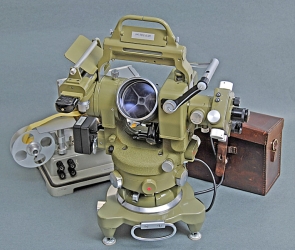Scientific Instrument Society 25th Anniversary Exhibition
Navigation:
<< First | < Previous | Next > | Last >>
39 Collecting Surveying Instruments
Having started my own engineering surveying company over thirty years ago and a surveying instrument supply company subsequently, I “inherited” a number of surveying instruments from my own practice and as “trade-backs” from customers who purchased new instruments.
As a surveyor, understanding the functional elements of surveying instruments is fundamental to their use. Since an instrument’s design affects its productivity and throughput, the comparative evaluation of instruments is essential. In my case such comparisons helped to stimulate a more general interest, which eventually extended to the historical development of the instruments.
The introduction of electronic surveying instruments during the 1970s and more particularly during the 1980s resulted in the abandonment of many of the optical mechanical instruments. Whilst expensive, these instruments of relative modernity were often taken for granted and treated with scant regard. I recognised the change to electronics as the passing of an era, as work practices changed and methods became more automated. It was for these reasons that I initially got more interested in collecting these artefacts which dominated my early career.
Many collectors are attracted to the older antique “brass-style” instruments which, understandably, have more “romantic” appeal. The more recent vintage instruments are their descendants: they exhibit every bit as much ingenuity in their design and often attain results that earlier instruments aspired to. Whilst I have both types in my collection (and extend even to electronic instruments) I have tried to give coherence to my collecting by obtaining instruments which are development milestones and have resulted in the modern survey methods and techniques which are in current practice.
This instrument was designed by Heindrich Wild, the 20th century’s most successful innovator in the field of surveying instruments. The DKM-3A was manufactured by Kern Arrau, Switzerland and is a precision Universal Theodolite principally suited for the determination of Geographic Latitude, Longitude, Time and Azimuth when combined with a Chronograph such as the Favag model displayed behind it. The instrument is also well suited to the geodetic determination of angles for First Order Triangulation.
The short (140mm) telescope of the DKM-3A with a large objective diameter of 72mm had in effect a focal length of 420mm and the excellent resolving power made it suitable even for the observation of weak stars. The completely novel design of the ball-bearing main axis and the cam type levelling screws gave the instrument its distinctive dumpy and compact shape. The impersonal micrometer and the convenient 90 degree viewing eyepiece make it particularly suited to the viewing and measurement of heavenly bodies.
Collection: John Bradley, Dublin
Objects lent by John Bradley, Dublin, Ireland:

